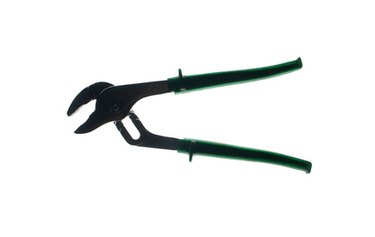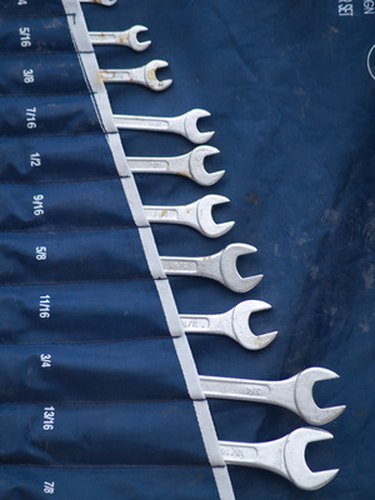
The term "channel locks" refers to a brand of slip-joint pliers produced by Channellock, Inc. Slip-joint pliers differ from wrenches in both appearance and application. Whereas slip-joint pliers grip rounded and flat-sided objects, wrenches typically grip only flat-sided objects. Slip-joint pliers and wrenches are essential components of a comprehensive tool kit. Whether you're working on cars or general construction, an understanding of both tools' capabilities allows you to choose the right one for your project.
Slip-joint Pliers
Video of the Day

A pair of slip-joint pliers essentially is a set of two separate handles riveted together at a fulcrum. Like standard pliers, each of the handles of a pair of slip-joint pliers connects to a gripping head. Hinged together, these separate gripping heads form a jaw that opens and closes to grip rounded and flat-sided objects. Unlike standard pliers, which hinge at a single, static fulcrum, the fulcrum point of slip-joint pliers is adjustable. The rivet, or peg, that connects the separate handles of slip-joint pliers rests in a channel. The builder can slide and lock this peg into different portions of the channel to widen or narrow the size of the gripping jaw's opening.
Video of the Day
Wrenches

The most common types of wrenches are box wrenches, socket wrenches and adjustable wrenches. Box wrenches have a solid, C-shaped, gripping head that slides around a flat-sided object, such as a nut. Socket wrenches are hollow, metal cylinders that fit precisely over a particular nut size. Adjustable wrenches are similar in function to box wrenches, but feature an adjustable head that allows the wrench to grip objects of varying size. The key feature of all wrench types is that they grip objects with flat, parallel sides, such as hexagonal nuts or square objects.
Applications of Pliers
Slip-joint pliers and other pliers are suitable primarily for gripping and twisting rounded objects. The interior edges of the pliers' gripping jaws are lined with pointed serrations that grab and hold. Whereas the serrations prove useful when attempting to grip rounded objects, such as pipes, they often deform and damage flat-sided objects, such as nuts.
Applications of Wrenches
Wrenches are suitable for gripping objects with at least two flat, parallel sides, such as hexagonal and square nuts. The gripping heads of the most common types of wrenches are composed of two parallel, opposing surfaces. The pipe wrench is a common exception to this assertion. The pipe wrench features a set of serrated, parallel gripping edges, which suit the tool for gripping flat-sided and rounded objects. However, as is the case with pliers, the pipe wrench's serrated edges deform and damage soft metals.